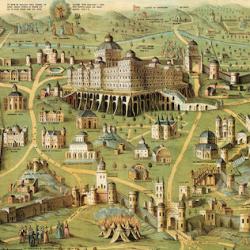House of Prayer, 1 Kings 8:1-66
INTRODUCTION
As Chronicles makes clear, one of the big changes in worship at the time of Solomon was in the area of music. David organized a Levitical choir and orchestra, and these accompanied the sacrificial music with song. As 1 Kings 8 makes clear, another big change has to do with prayer. Many sacrifices are offered at the dedication of the temple (1 Kings 8:62-66), but the emphasis of the dedication is on prayer addressed toward the house. Solomon?s temple is a ?house of prayer for all nations?E(Isaiah 56:7).
THE TEXT
?Now Solomon assembled the elders of Israel and all the heads of the tribes, the chief fathers of the children of Israel, to King Solomon in Jerusalem, that they might bring up the ark of the covenant of the Lord from the city of David, which is Zion . . . .?E(1 Kings 8:1-66).
NEW COVENANT
8:1 describes the assembly of the elders and heads of tribes to Jerusalem, and verse 66 describes the dispersal. This gathering-dispersal forms a frame around the passage. Within that, you have a fairly clear chiastic structure:
a. Assembly, 8:1-2
b. Sacrifice and ark, 8:3-13
c. Sol?s blessing of the people, 8:14-21
d. Solomon stands before the altar, 8:22
e. Solomon?s invocation, 8:23-30 (exodus)
f. 3 Petitions, 8:31-36
g. General petition, 8:37-40
f?E 3 Petitions, 8:41-51
e?E Invocation, 8:52-53 (Exodus)
d?E Solomon arises from kneeling before altar, 8:54
c?E Sol?s blessing of the people, 8:55-61
b?E Sacrifices and feast, 8:62-65
a?E Dispersal, 8:66
The word ?assembly?Eis used repeatedly, and helps to give structure to the passage. In verses 1-2, the verb ?assemble?Eis used. When Yahweh?s glory fills the MHP of the temple and Solomon dedicates the house to Him, He ?faced about and blessed all the assembly?E(v. 14). At the start of his prayer, He turns toward the altar ?in the presence of all the assembly?E(v. 22), and for the next thirty verses, he is praying in the presence of the assembly, but facing the altar. Then he turns and blesses the assembly (v. 55), and the assembly observed the feast (v. 65). By this repetition, the writer of Kings emphasizes the connections between this dedication and the ?assembly?Eat Sinai (Exodus 35:1; Deuteronomy 4:10). Moriah, the temple mount, is a new Sinai, and the dedication of the temple marks Israel?s entry into a ?new covenant.?E
The newness of the temple system is evident when we consider the ark?s role in Kings. In 1 Kings 7, the ark is a mark of continuity with the Mosaic covenant, since it contains the ?tablets?E(8:9) or ?the covenant?E(8:21). Once the ark is in the temple, it disappears from Kings; the story of the ark?s capture, return, exile, and final resting place comes to an end. This cannot be accidental: and it cannot be simply a matter of ?losing?Ethe ark. The ark?s role was temporary (like the role of the Mosaic covenant itself), and lasted only so long as there was no house for Yahweh to rest in (cf. Jeremiah 3:11-18).
PRAY TO THIS TEMPLE
Solomon?s prayer is one of the great prayers in Scripture. It is largely a prayer about prayer, an intercessory prayer from the King asking that Yahweh would hear the prayers of the King?s people. The passages points to several important features of prayer. First, in the dedication ceremony, prayer is emphasize more than sacrifices. This is in contrast to the presentation in the Pentateuch. The scene at the beginning of 1 Kings 8 repeats the scene at the end of Exodus, and in the Pentateuch, Yahweh immediately follows with instructions about sacrifices (Leviticus 1-7). In 1 Kings 8, Solomon speaks after the glory comes on the temple, and he speaks a lengthy prayer instead of instruction in sacrifice. We have a hint of the transition from Old to New Covenants, when the offering of animals is replaced by the sacrifices of the lips.
Second, 1 Kings 8 highlights the importance of mediators in prayer. On the one hand, Solomon and the Davidic kings function as mediators for the people. There is a subtle interplay throughout the prayer between the prayers of the king and the prayers of the people. In verse 28, Solomon speaks of the prayer of ?Thy servant,?Ebut in verse 30 it is prayer of ?Thy servant and Thy people.?E Israelites have the privilege of addressing prayers directly to Yahweh, both as a nation and individually (8:38, 41-43). But the King?s prayer opens up the channel of communication. Because of the king?s prayer, Yahweh?s eyes will ?listen?Eto the prayers of the people, as Solomon?s prayer remains before Yahweh as a continual memorial.
Interestingly, the house of Yahweh also functions as mediator, a communications exchange. Yahweh?s ?name?Eis present in the temple (which is perhaps a reference to the Second Person of the Trinity), and Solomon makes it clear that the temple does not ?contain?EYahweh. Yet, prayer is offered ?toward the house?Eor ?toward the city?E(vv. 33, 35, 38, 42, 44, 48), and Yahweh then is asked to ?hear from heaven.?EThe house is the visible sign of God?s presence. Israel prays toward it, and then the petitions are delivered to the heavenly Father.
Finally, it is important to note the emphasis on prayer from the heart in the central petition (vv. 37-40). There was nothing automatic about prayer toward the temple. In both the Old and New covenants, prayer is about the condition or inclination of the heart.
Throughout Kings, virtually no one follows Solomon?s implicit instructions. The temple stands in Jerusalem, and almost no one prays in or toward it (cf. 2 Kings 19:1-19). The temple is a great source of blessing for Israel, but Israel fails to make use of it.
CONCLUSION
These principles of prayer are fulfilled in Jesus. He is the greater Solomon, the King whose petitions to His father open up a channel of communication for His people. He is also the temple, the one ?toward whom?Ewe pray, where the ?eyes?Eof the Lord are found. When we pray ?toward this place,?Ethe eyes of the Lord hear and He answers.















